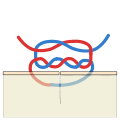Granny knot
The granny knot is a binding knot, used to secure a rope or line around an object. It is considered inferior to the reef knot (square knot), which it superficially resembles. Neither of these knots should be used as a bend knot for attaching two ropes together.
The granny knot is also called the false, lubber's, calf, and booby knot. Patterson's Nautical Encyclopedia calls it "old granny knot" and Sir Edwin Arnold calls it the "common or garden knot." The name granny is given in Vocabulary of Sea Phrases (Anonymous, 1799) and Roding pictures the knot in 1795.
The granny consists of two identical half knots, one tied on top of the other. It has but one practical purpose that I know of and that is to serve as a surgeon's knot. Formerly it was employed for tying up parcels in five-and-ten-cent stores, but the practice was given up and paper bags substituted as they were found to be simpler.
| Granny knot | |
|---|---|
 | |
| Names | Granny knot, false knot, lubber's knot, calf knot, booby knot |
| Category | Binding |
| Origin | Ancient |
| Related | Reef knot, thief knot, grief knot |
| Releasing | Often jams |
| Caveat | Should not be used as a bend. Inferior to reef knot for binding purposes, it can release suddenly and unpredictably. |
| ABoK | #3, #80, #186, #464, #1206, #1405, #2553, #3786 |
Etymology
Called the "granny's knot" with references going back to at least 1849, the knot was so-called because it is "the natural knot tied by women or landsmen".[2][3] It has also been suggested that rather than impugning the knot-tying skill of grandmothers, the name "granny" may be a corruption of granary after its possible use tying the necks of grain sacks.[4]
Tying
When attempting to tie a reef knot (square knot), it is easy to produce a granny knot accidentally. This is dangerous because the granny knot can slip when heavily loaded. A tightened granny knot can also jam and is often more difficult to untie than the reef knot. It is better to tie a reef knot in nearly all circumstances. One way to distinguish them is that in the reef knot each loop passes completely over, or completely under (not through) the neck of the other.
The reef knot is commonly taught as left over right, tuck under then right over left, tuck under. The granny knot is the first step repeated twice, left over right, tuck under. This is a very common mistake made by people learning to tie a reef knot.

Heraldry
In heraldry, the granny knot is known as the Bourchier knot, due to being a heraldic badge of the Bourchier family.[5]
Related knots
References
- Ashley, Clifford W. (1944). The Ashley Book of Knots, p.220-21. Doubleday. ISBN 0-385-04025-3.
- Smyth, William Henry (2008) [1867], Sir Edward Belcher (ed.), The Sailor's Word-Book, Project Gutenberg, p. 346
- Melville, Herman (1849). Redburn.
- Budworth, Geoffrey (2000), The Illustrated Encyclopedia of Knots, New York: Lyons Press, p. 40
- Arthur Charles Fox-Davies, A Complete Guide to Heraldry (1909), pp. 390, 469.
External links
| Look up granny knot in Wiktionary, the free dictionary. |
- "The Reef Knot Family", NotableKnotIndex.webs.com.



